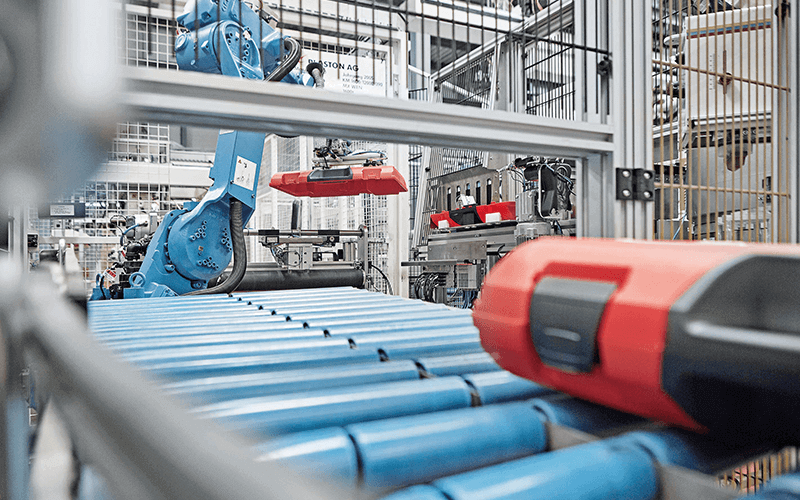PLASTON AG: Production with perspective – thanks to QlikView
PLASTON AG
Industry
Plastics processing
Department
Production, Sales and Company-wide roll-out in planning
Region
Widnau, Switzerland
“By using QlikView, we were able to easily consolidate MES and ERP data for the first time and increase evaluation flexibility. We now have an optimised production control system and effective management tool.”
Martin Schegg, Head of Global Operations, PLASTON AG
The customer
PLASTON AG has specialised in the development, manufacture and distribution of plastic products for more than 50 years. The focus is on the production of industrial cases, for example for power tools such as drills. More than four million of these quality cases are produced each year, and around 40 tonnes of plastic granulate are processed daily. The company is regarded as a leading global supplier of plastic packaging solutions. The company's range of services also includes sophisticated plastic visible parts for equipment and machine housings as well as the assembly of technical components. The service covers the entire value-added cycle from development, production and finishing to logistics.
The company is part of the PLASTON Group, which employs around 450 people at three production sites in Switzerland, the Czech Republic and China, as well as at a sales office in the USA.
Initial situation
In order to better meet the company's own high standards for quality and efficiency of products and processes, the company's reporting system was to be optimised. "Previously, we only had limited, static reporting options at our disposal," says Martin Schegg, Head of Global Operations, PLASTON AG. "In addition, the loading and processing time was too long for our needs."
PLASTON was looking for a dynamic business intelligence solution that could map all analysis and reporting requirements. The data basis was to be information from the manufacturing execution system (MES) T.I.G. as well as from the enterprise resource planning system (ERP) Microsoft Dynamics.
Also important to the plastics professionals were a high level of user-friendliness and the ability to visualise data graphically to make it easier to understand.
"We have evaluated several BI products in the past. Some of these were not feasible for us because of the necessary investments in database servers. Other cube-based BI systems did not meet our expectations due to the development effort involved," explains Carsten Sacher, Head of Information Technology, PLASTON AG.
Solution
"PLASTON found the right solution through the MES provider. The latter provides customers with a BI cockpit based on the data discovery solution QlikView. Even at first glance, QlikView looked like the solution that could meet PLASTON's requirements - which was confirmed at second glance, says Sacher. "We also took a closer look at some references and were then pretty quickly sure that QlikView was exactly the tool we needed."
The data discovery platform enables the consolidation of relevant data from various sources in a single application through its storage-based technology. Users can examine data in all directions in a self-service process and evaluate it independently. Various visualisation functions ensure a comprehensible presentation of the evaluation results.
PLASTON brought the Liechtenstein company ppmc AG on board to implement the project. The decisive factor was not only their BI expertise - the IT service provider is a certified QlikView Solution Provider - but also the physical proximity, as the Head of Information Technology emphasises: "People do a lot online these days, but it's simply more pleasant and goal-oriented for us to be face to face. Our ppmc contact person comes to us and we then work together on the respective topics directly."
First, a QlikView Server Small Business Edition was set up and the connection of the data from the MES and ERP system was realised. Here, too, ppmc was able to score with its comprehensive technological expertise in ERP and MES.
For the highest possible efficiency in terms of licensing costs, ppmc developed a cockpit through which users can navigate to different areas.
Areas of application and benefits
"Users can jump from a home page to the information that is relevant to them," says Sacher. "The information that is not relevant is hidden."
Production can, for example, compare the performance of the different machines or time periods with each other or call up evaluations about the individual shifts. Defined reasons for downtime can also be evaluated individually on an ad-hoc basis.
Analyses of the top/flop products and evaluations of orders according to criteria such as machine group, article, tools and customers are also available. Typical key figures such as Overall Equipment Effectiveness (OEE), Total Equipment Efficiency (TEE), quality rate and degree of utilisation can also be called up.
"We produce products from our range of over 1,000 different articles in three shifts every day," says Schegg. "In the past, we could only see where there were which problems or failures after the end of the third shift, i.e. after 24 hours. Today, we can call up information directly and intervene immediately in a controlling manner if we see that there are deviations in the normal production process."
For the Sales division, the cockpit offers sales and turnover analyses according to criteria such as customer, article and product groups - at group level (for this purpose, the respective national currency is automatically converted into Swiss francs) and broken down to the level of the individual branch. In addition, the contribution margin calculation with cost of sales as well as annual comparisons are displayed.
Future
The use of QlikView is to be further expanded. The wish list includes applications for purchasing, warehousing, quality management and margins. The data discovery platform is to be made available to users at all company locations.









